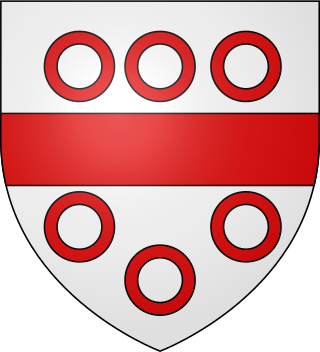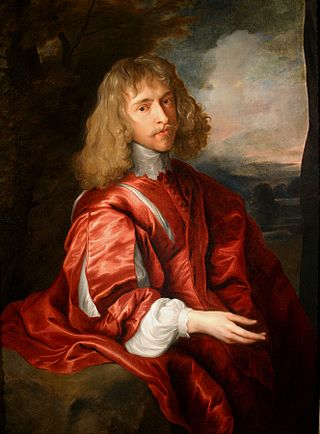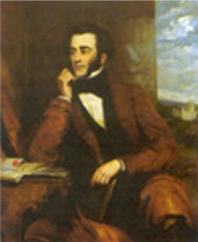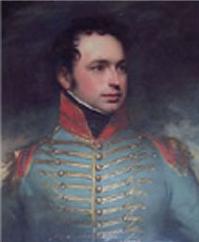
Thomas Herbert, 8th Earl of Pembroke and 5th Earl of Montgomery,, styled The Honourable Thomas Herbert until 1683, was an English and later British statesman during the reigns of William III and Anne.

Henry Howard Molyneux Herbert, 4th Earl of Carnarvon,, known as Lord Porchester from 1833 to 1849, was a British politician and a leading member of the Conservative Party. He was twice Secretary of State for the Colonies and also served as Lord Lieutenant of Ireland.

Hon. Auberon Edward William Molyneux Herbert was an English writer, theorist, philosopher, and 19th century individualist. He was a son of the 3rd Earl of Carnarvon. He was Liberal Member of Parliament for the two-member constituency of Nottingham from 1870 to 1874.

Baron Lucas is a title that has been created twice in the Peerage of England. The second creation is extant and is currently held with the title Lord Dingwall in the Peerage of Scotland.

Baron Dormer, of Wyng, County of Buckingham, is a title in the Peerage of England. It was created on 30 June 1615 for Sir Robert Dormer, 1st Baronet. He had, only twenty days earlier on 10 June 1615, been created a baronet "of Wing in the County of Buckingham", in the Baronetage of England.

Earl of Powis (Powys) is a title that has been created three times. The first creation came in the Peerage of England in 1674 in favour of William Herbert, 3rd Baron Powis, a descendant of William Herbert, 1st Earl of Pembroke. In 1687, he was further honoured when he was made Marquess of Powis.

Henry George Alfred Marius Victor Francis Herbert, 6th Earl of Carnarvon, was a British peer. He was the son of George, 5th Earl of Carnarvon, and Almina Wombwell.

Henry George Reginald Molyneux Herbert, 7th Earl of Carnarvon, , was a British peer and racing manager to Queen Elizabeth II from 1969 until his death. From his birth until September 1987, he was known by the courtesy title Lord Porchester.

Earl Cowper was a title in the Peerage of Great Britain. It was created in 1718 by George I for William Cowper, 1st Baron Cowper, his first Lord Chancellor, with remainder in default of male issue of his own to his younger brother, Spencer Cowper. Cowper had already been created Baron Cowper of Wingham in the County of Kent, in the Peerage of England on 14 December 1706, with normal remainder to the heirs male of his body, and was made Viscount Fordwich, in the County of Kent, at the same time as he was given the earldom, also Peerage of Great Britain and with similar remainder. He was the great-grandson of William Cowper, who was created a Baronet, of Ratling Court in the County of Kent, in the Baronetage of England on 4 March 1642. The latter was succeeded by his grandson, the second Baronet. He represented Hertford in Parliament. He was succeeded by his eldest son, the aforementioned William Cowper, the third Baronet, who was elevated to the peerage as Baron Cowper in 1706 and made Earl Cowper in 1718. In 1706 Lord Cowper married as his second wife Mary Clavering, daughter of John Clavering, of Chopwell, County Durham.

Henry Herbert, 1st Earl of Carnarvon PC, known as The Lord Porchester from 1780 to 1793, was a British Whig politician who sat in the House of Commons from 1768 to 1780 when he was raised to the peerage as Baron Porchester. He served as Master of the Horse from 1806 to 1807 in the Ministry of All the Talents headed by Lord Grenville.

Sir Robert Dormer of Wing, 2nd Baronet, 1st Earl of Carnarvon, 1st Viscount Ascott, 2nd Baron Dormer of Wing [or Wenge] was an English peer. He was the son of Sir William Dormer, and thus a grandson of Robert Dormer, 1st Baron Dormer. His mother was Alice Molyneux, daughter of Sir Richard Molyneux, 1st Baronet, and Frances Gerard. Dormer received the title Baron Dormer at the age of six and on 2 August 1628, at age 18, he was raised to Viscount Ascott and was created Earl of Carnarvon.

Henry John George Herbert, 3rd Earl of Carnarvon, FRS, styled Lord Porchester from 1811 to 1833, was a British writer, traveller, nobleman, and politician.
George Reginald Oliver Molyneux Herbert, 8th Earl of Carnarvon, styled Lord Porchester from 1987 to 2001, is a British peer and farmer.

Colonel Henry George Herbert, 2nd Earl of Carnarvon DL, FSA, styled The Honourable Henry Herbert from 1780 to 1793 and Lord Porchester from 1793 to 1811, was a British peer, nobleman, and Whig politician.

Sir Charles Dormer of Wing, 3rd Baronet, 2nd Earl of Carnarvon, 2nd Viscount Ascott, 3rd Baron Dormer of Winge was an English peer. On his father's death at the First Battle of Newbury, on 20 September 1643, he succeeded to his father's titles, at just 10 years of age. His mother had died in June, a few months earlier. He married twice, had four children, but his only son predeceased him and so when he died in 1709 the earldom and the viscountcy became extinct. The baronetcy and barony were inherited by Rowland Dormer, 4th Baron Dormer, a grandson of the second son of the 1st Baron Dormer.
George Augustus Frederick Cowper, 6th Earl Cowper, styled Viscount Fordwich until 1837, was a British Whig politician. He served briefly as Under-Secretary of State for Foreign Affairs under his uncle Lord Melbourne in 1834.

Pixton Park is a country house in the parish of Dulverton, Somerset, England. It is associated with at least three historically significant families, successively by descent: Acland, amongst the largest landowners in the West Country; Herbert, politicians and diplomats; and Waugh, writers. The present grade II* listed Georgian mansion house was built circa 1760 by the Acland family and in 1870 was altered by Henry Herbert, 4th Earl of Carnarvon (1831–1890). Although Pixton Park is situated within the manor of Dulverton, the manorial chapel relating to Pixton is situated not at Dulverton but within the Church of St Nicholas, Brushford, across the River Barle, as the lordship of the manor of Dulverton was held from 1568 by the Sydenham family seated at Combe House, on the opposite side of the River Barle to Dulverton and Pixton.

The Herbert family is an Anglo-Welsh noble family founded by William Herbert, known as "Black William", the son of William ap Thomas, founder of Raglan Castle, a follower of Edward IV of England in the Wars of the Roses. The name Herbert originated in 1461 when William was granted the title Baron Herbert of Raglan, having assumed an English-style surname in place of his Welsh patronymic, ap William.
Elizabeth Herbert, Countess of Carnarvon was an English noblewoman and the wife of Henry Herbert, 1st Earl of Carnarvon.
Jean Margaret "Jeanie" Herbert, Countess of Carnarvon,, was an American-born British aristocrat and chatelaine of Highclere Castle.




















